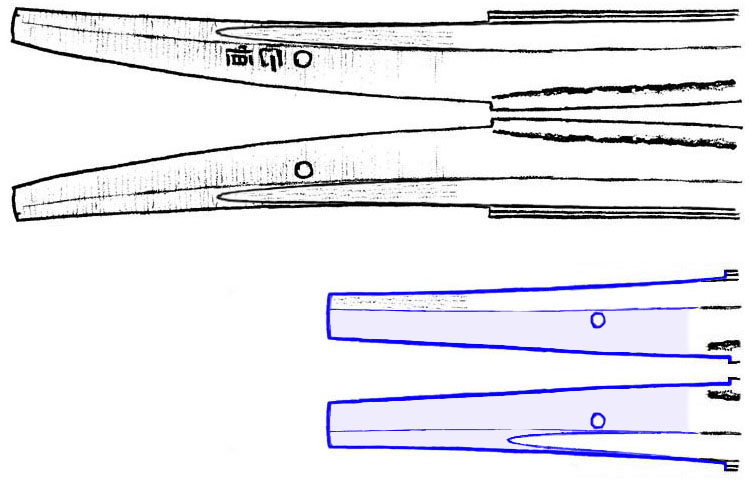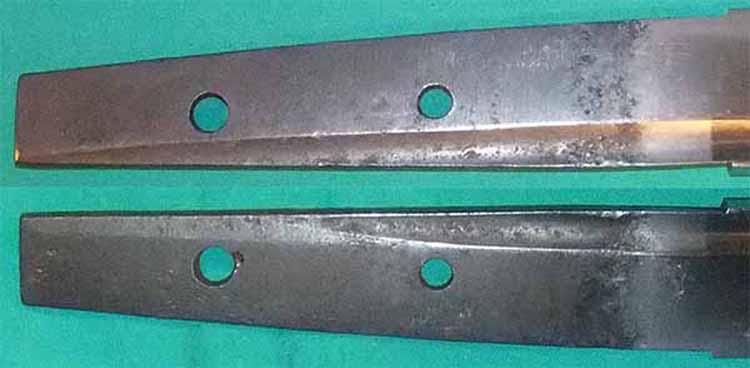By lyuesword | 30 October 2020 | 2 Comments
Manner of Blade Shortening (SURIAGE)
Manner of Blade Shortening (SURIAGE)
There are several styles by different amounts of blade shortening. The blade shortening work or the shortened blade is called "Suriage".
Examples of original tang, by hand drawing.

Machi-okuri (= Machi moved)
The tang keeps original, but the machi's are moved upward. It is done to shorten the blade length a little. So the tang length is extended. Such a small shortening is not called Suriage. It is just a "Machi-okuri". The upward side surface of the tang is ground with file sometimes to get a proper taper of thickness.
The tang keeps original, but the machi's are moved upward. It is done to shorten the blade length a little. So the tang length is extended. Such a small shortening is not called Suriage. It is just a "Machi-okuri". The upward side surface of the tang is ground with file sometimes to get a proper taper of thickness.



Suriage (= shortened blade)
The blade is shortened, but a part of the original tang is kept on one side.
The machi's are moved upward, the bottom of the tang is cut off, the back side and cutting edge side is filed, to shape new tang. The obverse surface of the tang isn't touched to respect the original, even if originally unsigned. The upward side surface is ground off to get a proper taper of thickness. Therefore, in the case of the tang that has grooves running on it, the groove on groove side becomes shorter by the grinding work.
The new tang occurs a small bend by one side grinding, so it is straighten again.
There is one more reason why the tang is ground such way, that comes from steel construction. Usually the core is milder than the outer surface in the meaning of tempered steel. So one side grinding means to keep the tang harder too.
Sometimes, the original tang is left a few inches at the bottom of new tang, and signature of the smith is there.
On the work of blade shortening, the hamon area is too hard to grind it off with file. So some part of hamon is heated to make it mild. Sometimes the hamon is vanishing by the heat.
In the suriage work, there is a rule of filing mark and tang end shape. The new file work must be done right angle and cut the end straight, regardless of the original file mark or original end shape. This rule makes it easy to find re-shaped tang and distinguish the original part left in it. But it is not an exact rule before 16th century.



An example of newly shortened blade by the work of Suriage:

On the obverse, the lower part where has a signature is original. The upper part is newly filed. The upward side is all new filing. The hole is newly drilled. The small arc at the end of the tang is a trace of original hole.
O-Suriage (large suriage = much shortened blade)
So much shortened as most of the original tang cut off, and fully re-shaped.
The work is the same to that of Suriage. In this case also, one side should be kept its skin steel.


An example of proper way of O-suriage:

Another way of O-suriage. Sometimes the tang is ground on both sides.

Usually the word "O-suriage" is used for the tang that doesn't have any original part on it, but it doesn't always mean much shortened. If the blade is not so much shortened and all the surfaces are re-filed removing inscriptions, it can be easily called O-suriage. But, it is not O-suriage in its exact meaning. It is just a short suriage, though the signature is not left on it.
So much shortened as most of the original tang cut off, and fully re-shaped.
The work is the same to that of Suriage. In this case also, one side should be kept its skin steel.


An example of proper way of O-suriage:

Another way of O-suriage. Sometimes the tang is ground on both sides.

Usually the word "O-suriage" is used for the tang that doesn't have any original part on it, but it doesn't always mean much shortened. If the blade is not so much shortened and all the surfaces are re-filed removing inscriptions, it can be easily called O-suriage. But, it is not O-suriage in its exact meaning. It is just a short suriage, though the signature is not left on it.

Want a unique sword? Feel free to contact us:
Email: lyuesword@hotmail.com
Website: www.lyuesword.com
Custom Sword Page: www.lyuesword.com/Custom-Sword/customization-options/Create-Your-Own-Swords
Recently Reviews
Read MoreLeave a Reply
Your email address will not be published.Required fields are marked. *